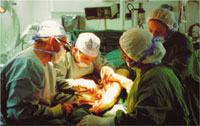Arterial Disease
|

Dr. Brantigan (with magnifying glasses) in
the operating room
at Mostafa Kamel
Armed Forces Hospital in Alexandria, Egypt. |
An artery is a muscular tube that allows blood to flow freely to
all parts of the body with the pumping action of the heart. The
arterial system carries oxygen and nutrients to all parts of the
body.
Disease occurs with a build up of a fatty substance (plaque)
along the inside of the wall, it's like corrosion in a pipe. As
plaque thickens, a narrowing is created. The result of severe
narrowing of arteries can cause heart attacks, strokes, or ulcers,
extremity pain and limb loss.
The largest artery is called the aorta. The aorta starts the
heart and travels to the muscles of the belly. It branches into
several different arteries supplying blood flow or pulses to every
organ of the body.
Use these links for further information:
National Vascular Surgery Societies
www.vascularweb.org
Society of Vascular Ultrasonography
www.svunet.org
Society for Vascular Nursing
www.sunnet.org
VascularWeb: Northpoint Conditions, & Treatments
Looking for information on vascular conditions, tests, and
treatments? Please use the VascularWeb Northpoint links
below provided by the Society of National Surgery.
|